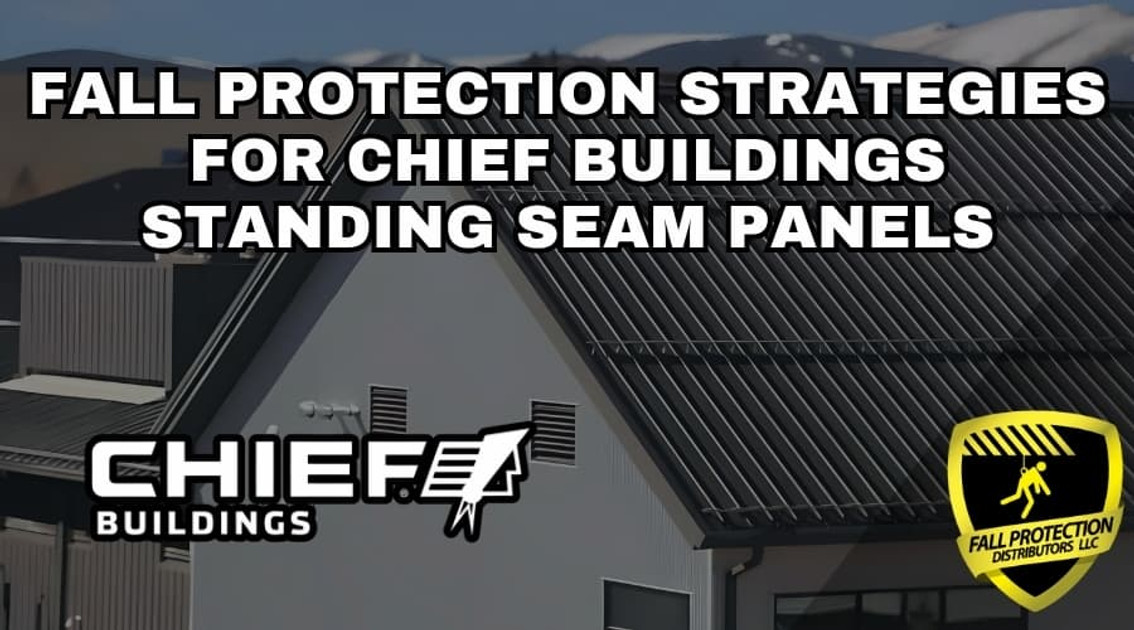Fall Protection for Chief Buildings Standing Seam Panels
Posted by Howie Scarboro - CEO Fall Protection Distributors, LLC on Nov 14th 2025
See the Roof Anchor Compatibility Chart for Chief Buildings Standing Seam Metal Roofing.

Who Is Chief Buildings?
Chief Buildings brings more than seventy years of metal building expertise, advanced manufacturing, and structural innovation to commercial and industrial projects across the country.
Chief Buildings grew from a small construction outfit in Grand Island, Nebraska, into one of America's most trusted engineered metal building manufacturers. The story started in 1954 with Virgil Eihusen, whose remodeling work expanded into grain bins, factory fabrication, and eventually the metal building systems that define the company today. Three generations later, Chief Buildings still operates as a family-owned business with a national footprint and a strong commitment to quality.
Over the years, Chief added divisions, sharpened its engineering capabilities, and invested heavily in automation. Recent milestones include the new Lancaster, South Carolina, plant with its first robotic welder and ongoing expansions in Nebraska and Indiana. Recognition follows that steady growth through awards from the Metal Construction Association, industry leadership honors for DJ Eihusen, and community-driven programs that support the company's workforce and the places they call home.
Seven decades in, Chief Buildings continues to deliver structural steel systems that balance precision manufacturing with long-term durability. The company remains rooted in its Midwestern values while pushing forward with modern technology and design.
What Are The Most Compatible Fall Protection Anchors For Chief Buildings?
Chief Buildings' standing seam panels work best with non-penetrating fall protection that grips the seams securely while keeping every system OSHA and ANSI compliant.
Standing seam roofs from Chief Buildings require anchors that lock onto the seams without drilling. These roofs rely on thermal expansion to stay weather-tight, and even a single misplaced screw can damage a seam or void a warranty. That is why non-penetrating fall protection anchors are the only safe approach.
The SSRA1 Standing Seam Roof Anchor uses 12 stainless steel set screws to attach to the seam without penetrating the roof. This attachment method creates a strong tie-off point on 22- and 24-gauge steel Chief Buildings panels while preserving the roof's weather-tight performance. A pair of SSRA2 Adjustable Roof Jack Adapters mounts on top of two SSRA1 Anchors. These adapters adjust for both roof pitch and seam height, providing crews with a stable platform to support 10-foot walkboards.
When a job requires temporary horizontal lifelines, the SSRA3 Anchor Plates expand the system's capability. These plates mount on the SSRA1 anchors, making them essential when workers need continuous mobility along larger Chief Buildings roof runs. The SSRA HLL 100 Foot Temporary Horizontal Lifeline Kit combines four SSRA1 Anchors, two SSRA3 Anchor Plates, and the Malta Dynamics HLL3001 system into one complete OSHA-compliant package. This kit provides workers a temporary non-penetrating lifeline system that protects both the crew and the metal roof.
When buildings require year-round rooftop access, the Super Anchor 120-Foot Permanent Horizontal Lifeline Kit becomes a major advantage. This system stays installed permanently, eliminating the need for repeated setup time while maintaining safe tie-off points for long-term maintenance crews.
For Chief Buildings roofs with slopes from 6:12 to 12:12, the Ridge Pro Steep Assist Anchor hooks over the ridge and provides a secure tie-off before workers ever step onto the panel surface. It remains non-penetrating and provides dependable access for steep-slope structural standing seam profiles.
MSC Panel (Mechanically-Seamed)
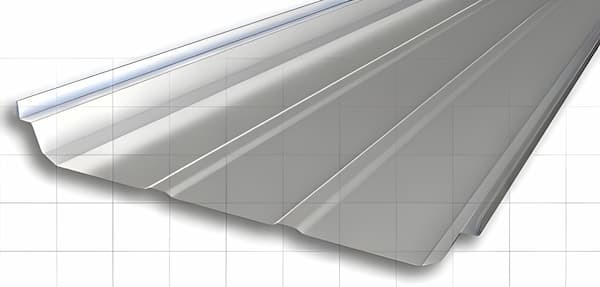
Chief Buildings' MSC panel features a 3-inch mechanical seam, creating a strong, low-maintenance roof suited for commercial and industrial applications.
The MSC panel is one of Chief Buildings' most dependable mechanically-seamed systems. Each panel is 24 inches wide and up to 50 feet long, reducing end laps and providing a cleaner structural line for the roof. The tall, 3-inch seam increases rigidity, moves water efficiently, and performs well in climates that see heavy rain or snow. See the Roof Anchor Compatibility Chart for Chief Buildings MSC Standing Seam Metal Roofing.
Chief Buildings rolls the MSC profile in 22- and 24-gauge steel, and the system works on shallow slopes down to 1/4:12. The sliding clip design allows the panel to expand and contract with temperature shifts, protecting the seams from stress and helping the roof stay weather-tight through seasonal changes. Buyers can choose from a range of factory-applied finishes applied over an acrylic-coated Galvalume base, providing the system with long-term color stability and corrosion resistance.
Fall Protection for MSC Panels
Non-penetrating anchors provide crews with a safe way to tie off to MSC panels without interfering with the mechanical seams or the sliding clip system.
The SSRA1 Standing Seam Roof Anchor works well on MSC panels because it uses twelve stainless steel set screws to grip the seam without making a single hole in the panel surface. Crews lock it in place on 22 and 24-gauge steel versions of this profile when they need a dependable single-user tie-off point during installation or maintenance. To create a safe working platform on steeper roofs, a pair of SSRA2 Adjustable Roof Jack Adapters mounts on two SSRA1 anchors. These adapters allow ten-foot walk boards to sit level on MSC roofs, and the adjustable design lets crews match the pitch and seam height so walk boards stay secure and comfortable to use.
When a project requires more worker movement along the length of an MSC roof, the SSRA3 Anchor Plates expand the system's capabilities. These plates sit atop the SSRA1 anchors and carry the applied loads from temporary horizontal lifelines. They pair perfectly with the SSRA HLL 100 Foot Temporary Horizontal Lifeline Kit, which includes four SSRA1 anchors, two SSRA3 plates, and the Malta Dynamics HLL3001 lifeline system. For buildings that see regular rooftop access, the Super Anchor 120 Foot Permanent Horizontal Lifeline Kit offers a long-term solution that stays in place year-round.
On MSC roofs with slopes between 6:12 and 12:12, the Ridge Pro Steep Assist Anchor gives workers a secure way to reach the ridge before stepping onto the panel surface. It hooks over the peak and creates a non-penetrating tie-off that protects the roof and keeps crews safe on steep structural profiles.
MVF and MVP Panels (Mechanically-Seamed)

These Chief Buildings panels use a 2-inch vertical seam and a modern clip system that creates a clean architectural line and dependable low-slope performance.
Chief Buildings' MVF and MVP profiles are premium mechanically seamed roof systems for projects that require a sturdy, attractive standing-seam design. Each panel comes in 16- or 18-inch widths and is made of 24-gauge steel, providing a balance of strength and manageable weight. The 2-inch vertical seam improves rigidity and efficiently directs water across low-slope roofs with pitches as low as 1:12. The only difference between the two panels is the pencil ribs located every 4 inches on the MVP panel. The MVF panel is flat with no pencil ribs. See the Roof Anchor Compatibility Chart for Chief Buildings MVF and MVP Standing Seam Metal Roofing.
These panels attach with a dedicated clip system that runs along the purlins. The clips hold the panel securely while allowing the roof to expand and contract with changing temperatures. That design keeps the seams tight, protects the finish, and gives the roof the smooth appearance that architects expect from a vertical leg standing seam profile. The result is a durable standing seam roof that performs well on commercial, industrial, and architectural structures.
Fall Protection for MVF and MVP Panels
Crews can tie off safely on MVF and MVP roofs using non-penetrating anchors that grip the vertical seam without damaging the steel panels.
The SSRA1 Standing Seam Roof Anchor gives installers a dependable tie-off point on MVF and MVP roofs. The anchor grips the seam with 12 stainless steel set screws and does not penetrate the panel surface. This attachment method keeps the steel intact, protects the roof from leaks or warranty issues, and still provides a solid fall arrest point. A pair of SSRA2 Adjustable Roof Jack Adapters mounts on two SSRA1 anchors and creates a strong support for ten-foot walk boards. Crews adjust each adapter to match the pitch and seam height of the MVF or MVP profile, which keeps walk boards level and steady during installation or maintenance.
When a project requires more worker movement on wider roof areas, the SSRA3 Anchor Plates extend the system into a full horizontal lifeline setup. Each plate mounts to an SSRA1 anchor and connects directly to the lifeline hardware. This configuration pairs with the SSRA HLL 100 Foot Temporary Horizontal Lifeline Kit, which includes four SSRA1 anchors, two SSRA3 plates, and the Malta Dynamics HLL3001 lifeline. Buildings that need permanent tie-off points benefit from the Super Anchor 120 Foot Permanent Horizontal Lifeline Kit. This kit stays in place year-round, giving maintenance crews a reliable rooftop system without having to set up new anchors each visit.
On MVF and MVP installations with slopes from 6:12 to 12:12, the Ridge Pro Steep Assist Anchor offers another safe option. It hooks over the ridge and allows workers to reach the peak before stepping onto the panel surface. This approach creates a secure, non-penetrating tie-off for steep roof access.
STC Panel (Snaplock Style)
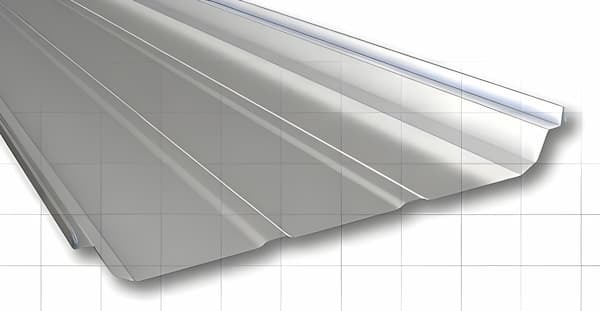
This snaplock standing seam panel uses a 3-inch vertical rib and a clip-mounted design that delivers strength, speed, and clean architectural lines.
Chief Buildings' STC panel gives builders a heavy-duty snaplock option built for commercial and industrial work. Each panel spans 24 inches and rises to a 3-inch seam height, creating a tall structural rib that sheds water quickly on long roof runs. Chief forms the STC system from 24-gauge Galvalume steel, so the panel arrives with excellent corrosion resistance and dependable long-term durability. See the Roof Anchor Compatibility Chart for Chief Buildings STC Standing Seam Metal Roofing.
The snaplock design locks each panel into the next while specialized clips secure everything to the purlins. This clip system keeps the seams tight and allows natural thermal expansion across the roof. It also works well with thermal spacers, which help improve insulation performance and energy efficiency in large buildings.
The STC profile shares the rugged build quality of the MSC panel. Still, it gives designers a snaplock option when mechanical seaming is not specified.
Fall Protection for STC Panels
STC panels support non-penetrating SSRA anchors that clamp to the 3-inch seam without damaging the 24-gauge steel.
The SSRA1 Standing Seam Roof Anchor gives installers a solid tie-off point on STC roofs. Workers attach the SSRA1 anchors with 12 stainless steel set screws that grip the seam without penetrating the panel. This attachment method protects the finish, preserves the weather-tight design, and provides a certified fall arrest connection. A pair of SSRA2 Adjustable Roof Jack Adapters mounts on two SSRA1 anchors to support standard ten-foot walk boards. Crews adjust the adapters for roof pitch and seam height to keep the platform level and stable across steep STC roof areas.
The SSRA3 Anchor Plates expand the setup for horizontal worker movement along the roof. Each plate mounts on two SSRA1 anchors to provide a stury anchor point for temporary horizontal lifelines. The plates work seamlessly with the SSRA HLL 100 Foot Temporary Horizontal Lifeline Kit, which includes four SSRA1 anchors, two SSRA3 plates, and the Malta Dynamics HLL3001 system. This complete kit keeps two workers tied off while working on large roof areas. Buildings that need routine rooftop maintenance often install the Super Anchor 120 Foot Permanent Horizontal Lifeline Kit. This long-term system stays in place year after year. It distributes loads across multiple SSRA1 anchors without drilling into the steel.
If the STC roof pitch sits between 6:12 and 12:12, crews can also use the Ridge Pro Steep Assist Anchor. The Ridge Pro hooks over the ridge and lets the worker connect their lifeline before stepping onto the metal surface. This approach gives installers a full tie-off from ladder to ridge and back again.
Standing Seam Roof Anchor Compatibility Chart For Chief Buildings
| MSC 22 Ga. | MSC 24 Ga. | MVF-MVP 24 Ga. | STC 24 Ga. | |
|---|---|---|---|---|
SSRA 1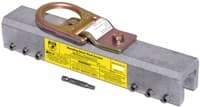 |
YES | NO | NO | NO |
SSRA1 Nylon Tip |
YES | YES | YES | YES |
SSRA2 Roof Jack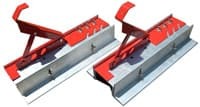 |
YES | YES | YES | YES |
SSRA3 Anchor Plate |
YES | YES | YES | YES |
The Ridge Pro |
YES | YES | YES | YES |
Contact Us for Expert Standing Seam Fall Protection Advice
For expert guidance on standing seam roof anchors, lifeline kits, and fall protection systems that protect both your crew and your panels, contact us today at 863-703-4522 or visit www.StandingSeamRoofAnchor.com. Our safety specialists can help you match the right non-penetrating anchor to your specific roof profile and slope. Let's make your next metal roofing project safe, compliant, and built to last.
For continued learning, download OSHA's 48-page Fall Protection Manual and our free Anchor Inspection Form once you've selected the ideal anchors for your roof system. Together, we'll help you stay ahead of OSHA standards while preserving your roof's weather-tight seal.
Safety Tips For Standing Seam Roofs
Equip Workers with High-Quality Safety Gear
Effective fall protection on Chief Buildings' standing-seam roofs begins with workers' trust in the gear. A properly fitted harness, a smooth-operating Malta Dynamics SRL, and connectors inspected before every shift give crews confidence when tying off to SSRA1 anchors or a Ridge Pro Steep Assist. OSHA's 2025 rules place major emphasis on sizing and inspection, High-quality gear is the backbone of every safe Chief Buildings jobsite.
Use Specialized Anchor Systems for Standing Seam Roofs
Chief Buildings panels perform best when paired with non-penetrating anchors built for precision seam attachment. The SSRA1 Standing Seam Roof Anchor clamps to the seam using 12 stainless steel set screws, providing a secure attachment without drilling through the Chief panels or jeopardizing warranty coverage. Stick to anchors rated for inch-pound torque to avoid seam deformation; many seam anchors rely on heavy torque attachment, which can damage the seams. Safety managers should avoid seam anchors that require locating hidden clips, as those clips are nearly impossible to find on completed Chief roofs.
Install Permanent Roof Anchor Systems
Facilities built with Chief Buildings' roof systems often require recurring access for HVAC service, inspections, or equipment upgrades. The Super Anchor 120-foot Permanent Horizontal Lifeline Kit offers a long-term solution that stays mounted year-round. It provides ready-made OSHA- and ANSI-compliant tie-off points without penetrating the Chief standing seam panels, reducing setup time and preserving the roof's weather-tight design.
Promote a Culture of Safety
A safe Chief Buildings project always begins with a team that communicates well. Crews that openly discuss hazards, share lessons from close calls, and look out for one another create a jobsite culture where safety becomes instinctive. A quick morning briefing before installing SSRA1 anchors or navigating long Chief roof runs can eliminate confusion and prevent fall-related incidents. Clear communication builds trust, and trust builds safer roofs.
Set Up Protective Guardrail Barriers for Work Zones
Guardrails remain one of the most effective ways to prevent falls on large Chief Buildings structures. Installed around skylights, parapets, and roof edges, they create visual and physical reminders that guide worker movement. When combined with seam-mounted SSRA anchors, guardrails help define safe work zones and reduce exposure to leading edges on high-span Chief roofs.
Develop OSHA-Compliant Safety Plans
Mapping out tie-off points, identifying rescue procedures, and assigning responsibilities transforms guesswork into confidence. Updated regularly, a well-structured plan ensures OSHA compliance and helps crews act quickly when conditions change or emergencies occur.
Consult Experts for Curved Metal Panels
Chief Buildings occasionally designs structures with curved or specialty standing seam roof sections, and such conditions require expert safety evaluations. A trained fall protection specialist can determine which fall protection strategies are best suited for curved roof systems. Professional review ensures OSHA compliance while protecting the roof's structural integrity.
Ensure Proper Footwear for Stability
Workers navigating Chief Buildings' roof systems need high-traction, slip-resistant roofing boots with firm ankle support. Proper footwear improves balance, reduces fatigue, and keeps workers safe. Combined with SSRA1 anchors or a Ridge Pro tie-off point, solid footing becomes a core element of worker safety on metal roofs.
Encourage the Use of Trauma Straps
Stopping the fall is only half the battle. Trauma straps give a suspended worker a way to relieve leg pressure and maintain circulation while waiting for rescue. These small, inexpensive accessories help prevent suspension trauma. Safety managers should include Trauma Straps in their safety plan and as standard equipment for all workers at height.
Prioritize Ladder Safety Training
Many falls occur before a worker ever reaches a Chief Buildings roof. Ladder safety training starts with inspecting the ladder for damage, setting the correct angle using the four-to-one rule, and maintaining three points of contact at all times. When crews take ladder use seriously, they set the tone for a safer workday long before any anchors or lifelines go into play.
Disclaimer
The views, recommendations, and information presented in this blog are solely those of the author and do not necessarily reflect the opinions or positions of the featured panel manufacturer, its brands, subsidiaries, or parent companies. Customers are strongly encouraged to contact the roof panel manufacturer directly for inquiries regarding fall protection compatibility with their products and to address any potential warranty issues that may arise after installing our products.

